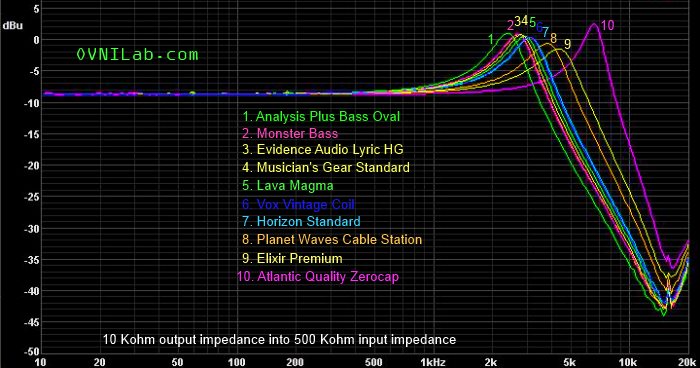Extensive compressor reviews and FAQ


Graphic demonstration of cable frequency response:
Advertisers and consumers talk about different cables performing differently in the highs, lows, and so forth. Spectrum analysis shows the actual frequency response of the cables, proving or disproving those statements. For this analysis I used TrueRTA software. The audio converter I used has an output impedance (z out) of 50 ohms, which is about the same as an active instrument; and an input impedance (z in) of 1 Meg, which is typical for most amp heads, both vintage and modern. I found that with those impedances, all of the cables had totally identical frequency response--meaning they do exactly the same job of conveying lows, mids, and highs, without variation, from 10 Hz to 20 KHz. You can see that here in an analysis comparing ten different cables, all about 20 feet long:

That single line is actually ten lines that overlap. The spikes at 60 Hz and 180 Hz are artifacts from the power wiring in the room. They occurred in different amounts each time I repeated the test, with each cable, so they do not indicate anything about any one cable versus others.
In order to show a visible difference in cable performance, I had to raise the z out and lower the z in. I raised the z out by running the test signal (pink noise) in series with a passive P-bass pickup, and I lowered the z in by putting a 1 Meg resistor in parallel with the input. This also shows an exaggerated view of the type of tone changes that can be heard with a passive guitar. Here is the new analysis of the same ten cables:

These charts demonstrate that with a passive instrument a cable's capacitance has a direct correlation to the amount of high-frequency content it can carry effectively. Also there is a significant spike in the frequencies just below the point where the highs drop off. The shape and frequency location of this spike and rolloff will change when you adjust the volume or tone knobs on your passive guitar. This graph also shows that even in an extreme case, the cables perform identically in the lows, and the mids never drop relative to the highs and lows. In other words, claims about a cable having "deeper, stronger bass", "scooped mids", or "polite low mids" are all completely false. In the case of a musician testing with their ears, these qualities are just in their imagination, a trick of our brains hearing what they want to hear--it honestly happens to the best of us.
In the case of a company that makes or sells these cables, those descriptions are not entirely honest. Sometimes they even use tone-describing terms like etching, glare, smearing, resolution, and so forth, but these descriptions are just meaningless garbage in the context of instrument cables. Here's a page where I tested those claims. They will also try to snow you with a bunch of scientific-sounding claims about inductance, skin effect, current bunching, and resonance--but those don't have any measurable or meaningful effect on audio frequencies in instrument cables. They are only relevant in the MHz and GHz ranges, at lengths of over a mile, so don't be fooled by the fake "science" in cable marketing.
In spite of those brain tricks or marketing voodoo, there can be some times when swapping different cables into your rig really will cause an audible difference! Here's how: a guitar's pickups, their vol/tone wiring, the cable, and the amp or pedal at the other end all interact to form a passive filter (a simple EQ). The cable variable that changes the shape of the filter is its total capacitance. As shown in the "visible difference" graphs above, this filter can roll off the highs, and boost a narrow hump just below that rolloff. The closer the z out value at one end of the cable is to the z in at the other end, the more exaggerated and audible the filter becomes; the graphs show an extreme example of this. Even small adjustments of your volume or tone knobs can have a noticeable impact on that filter shape.
However, with an ideal impedance relationship between two pieces of gear, the filter has no effect at all: the frequency response is perfectly flat, as shown in the first graph. A good-quality buffer (an active gain stage) creates an ideal impedance relationship. That's precisely why onboard preamps were invented. Additionally, a buffered output electronically isolates the cable from the pickups and pots, so the cable cannot interact with them.
There are a few active guitars and basses where the powered/buffered part (an EQ stage, or active pickups) is followed by passive vol/tone wiring going to the output jack. In those cases it's a bit of a gray area, because the pickups are isolated (removing their inductance from the filtering effect), but the vol/tone pots raise the overall output impedance significantly--so the cable capacitance may still have some audible effect.
For more about what this all means in practical terms, check out this page of examples. And of course you still have to consider the most important thing: how well were the cables made? Click here to read my opinions of the construction quality, and value, of the cables I tested.

nothing to see here
All text on this page written and owned by Cyrus Joaquin Heiduska, 2006-2024, all rights reserved.
Copying is prohibited, and AI scraping or training is prohibited. Instead, please link to this page using the link text "compressor reviews".
PRIVACY POLICY